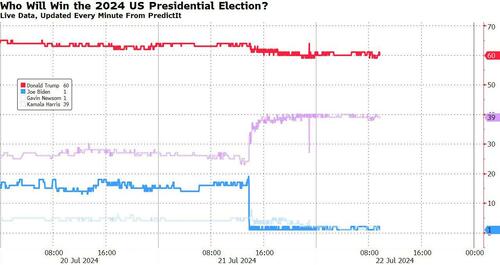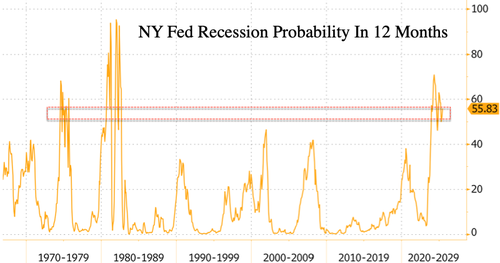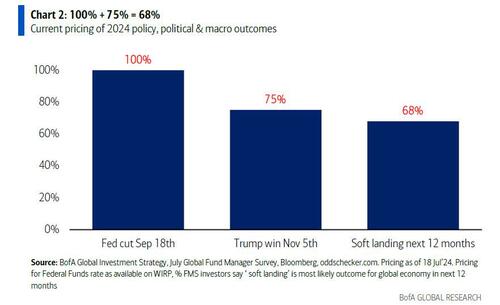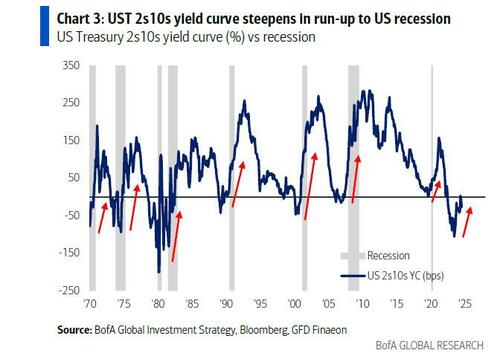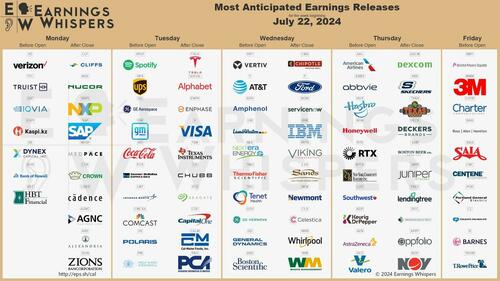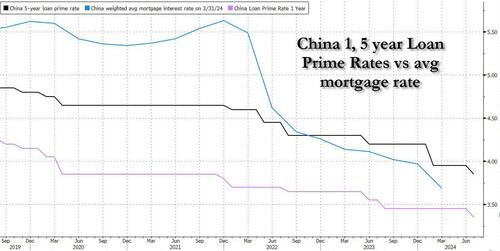ETH Is The High-Quality Liquid-Asset Of Crypto
Authored by Omid Malekan via Medium.com,
Satoshi Nakamoto had multiple insights, but the most profound may have been the use of circular logic to address an unsolved problem in the decades old field of distributed consensus.
Before Bitcoin, there was no known way to secure a permissionless system where participants were free to come and go. Nakamoto Consensus does it with incentives, the economics of which are circular.
Why is the decentralized Bitcoin network secure? Because the bitcoin currency has value. But why does the currency have value? Because its decentralized network is secure.
The critics who call this a ponzi don’t realize the circularity is a feature, not a bug. It allows for the system’s network effects to go to its users, as opposed to an authority. Bitcoin is a trillion-dollar asset that nobody controls but anyone can own. If it weren’t independent and decentralized it would just be a bad database.
Bitcoin Isn’t Perfect
Bitcoin is awesome, but there’s not much that you can do with it other than owning it. You can’t use it in DeFi — not natively anyway. The Bitcoin protocol is too limited to build DeFi on top of: block times are too slow and unpredictable, and the scripting language can’t do much.
There’s hope that a new generation of L2s or additional covenants can change this, but I remain skeptical.
The soul of Bitcoin is to solve a different problem than collateralized lending or DEX trading.
One solution is to bridge Bitcoin to other L1s, and there’s already $10b worth on Ethereum alone. But this too is imperfect. Secure bridges remain an unsolved problem in crypto and I doubt we’ll find a decentralized approach that is not bottlenecked anytime soon. The other solution is to use Bitcoin custodially, but that’s moving backwards.
Put together, these limitations mean that the most valuable and liquid asset in crypto can’t be used as the economic foundation for a new financial system. It will always be a part of that system — there’s plenty of bridged Bitcoin in Ethereum DeFi — but it can’t be the core of it. The core asset must be fully secure and completely decentralized.
The HQLA of Crypto
In traditional finance, a High Quality Liquid Asset is one that has broadly recognized value and substantial liquidity. The concept was introduced after the 2008 financial crisis to force banks to always hold a certain amount of safe assets that they can sell in a pinch without tanking the market. The most obvious example of HQLAs are US government bonds, which form the backbone of the international dollar system. Nobody questions their value, they can be bought and sold easily, and there’s seemingly endless capital willing to lend against them.
DeFi needs a crypto-native equivalent. Debt and derivatives are safer when built on top of an HQLA. Given the inherent risks of leverage, the one thing market participants shouldn’t have to think about is the quality of the collateral. HQLAs can fluctuate in value the way all assets do, but their reliability and liquidity should never be in question, even in a bear market. A crypto-native HQLA enables decentralized stablecoins, safer credit, and more scalable derivatives.
The most likely candidate for a crypto HQLA is the native coin of an L1 chain — a currency minted and controlled by a protocol that can only be altered via a fork. Native tokens offer the greatest property rights and monetary assurances. Tokens tied to dApps, on the other hand, may have smart contract risk and usually involve some kind of governance risk. Ceteris paribus, the token of a dApp will always be less valuable than the native token of the chain it rides on.
So will any individual L2 token. L2s inherit some of the security of the base layer so they lack full circularity — some of their activity will always accrue value to the L1. Stablecoins and other assets issued by a centralized entity have too much censorship risk. A truly permissionless CBDC might work, but is unlikely. Everything else in crypto is low quality.
That leaves us with ETH and SOL, the native assets of the two most valuable smart contract platforms, each of which has a robust native DeFi ecosystem. Each coin is the HQLA coin of its own chain, but financial systems have a winner-take-most tendency, so one is more likely to become the HQLA of the decentralized financial system. Despite the success and staying power of Solana, the platform, SOL the asset is of only medium quality.
Cryptoeconomics is not a meme
ETH is a lot more liquid than SOL, in part because ETH is more distributed and widely held than SOL. Its initial distribution happened almost a decade ago, and was modest by contemporary standards. Years of Proof of Work dampened concentration. Tokens that have only ever been Proof of Stake tend to have greater concentration because stakers don’t have to sell their income to fund operations the way miners do. Ethereum did not have any VC rounds and the Foundation took a small initial stake (again, by contemporary standards). There was no Labs or Ecosystem Fund. There are still concentrated pockets of ownership, but the overall distribution is broad.
SOL is a younger asset that had staking from launch. It began life more concentrated than ETH due to its VC rounds and gave allocations to the Labs, Foundation, and Ecosystem Fund. The FTX collapse helped diversify ownership, but wider distribution will always be capped by the fact that unlike ETH, SOL is not an appealing economic asset in of itself. People may want to own it for narrative reasons or to speculate, but its fundamentals are weak.
Solana has relatively high inflation, north of 5%. That rate will ratchet down every year until it hits a steady state of 1.5%, but supply will grow by 25% by then. This means that SOL has a high nominal interest rate, and that’s problematic for DeFi integration. Any asset backed by it (like a decentralized stablecoin) or margined with it (like a perp) will have a high cost of capital.
You can see this dynamic in action by contrasting the market rate for ETH in Aave to that of SOL on Kamino.
SOL owners can always stake to protect themselves from dilution — they’d be foolish not to. Inflation is sometimes argued to not be a problem in crypto because it’s just a wealth transfer from non-stakers to stakers. But it is a problem for HQLA consideration. Not only does it increase the cost of capital of DeFi, it also reduces liquidity. DeFi has to compete with staking to attract the native asset. Thus: most of the SOL in existence is currently staked.
Liquid staking tokens can serve as a workaround but are suboptimal. They have their own credit/counterparty risks and are less quality than the native asset, by definition. The problem on Solana is exacerbated by the fact that there’s no clear LST winner, so even the liquidity of its LSTs is fragmented. DeFi always prefers the native asset, but Solana doesn’t have a lot of it.
To be fair, liquid staking tokens are also popular on Ethereum, and Lido’s stETH features prominently in DeFi. But Ethereum has half the staking participation rate of Solana, thanks in part to its lower staking yield, which translates to a lower opportunity cost to doing other things with the native coin. These dynamics mean there will always be proportionally more free-floating ETH than SOL.
The other problem with SOL as an asset is that Solana transaction fees are too low. This might sound counterintuitive, but it’s important to remember that while fees are a cost to users, they are an additional source of revenues for validators. A chain that can pay its validators via fees doesn’t have to rely as much on issuance and can be secured with less inflation. Users on such a chain would also want to hold more of the native asset today to cover potential gas expenses in the future — sometimes referred to as the convenience yield.
High fees on a smart contract platform enable less new supply (because validators are paid with fees) and more current demand (because users need to hold at least some) for its coin — up to a point. High fees improve the moneyness of an L1 token, and moneyness is important for this conversation. The highest quality assets are derived from the best money.
The interplay between issuance and fees determine the real yield of a cryptocoin. Chains that have low inflation and high fees have a positive real yield: stakers earn a solid rate of interest without having their coin debased. ETH is the best asset in crypto in this category — even better than Bitcoin. The current ~3.5% staking rate comes mostly from fees (Bitcoin also has low issuance and high fees, but the fees go to miners, not coin holders). Solana has high issuance and low fees, so it has a borderline negative real yield. Almost all of the return stakers earn comes from debasement.
Note that MEV is also a factor in the nominal vs real calculation, but beyond the scope of this analysis. My guess is that Ethereum will always have higher MEV capture for stakers than Solana, but the situation for both chains is in flux.
Ethereum also has a burn mechanism that makes it deflationary during periods of high activity, increasing its positive real yield. The ability to earn interest in a potentially deflationary asset is special. Such an asset is in some ways the perfect HQLA, even better than US Treasuries, whose yield has to be viewed against the backdrop of increasing money supply. Ethereum’s burn mechanism also returns value to non-stakers, helping keep staking participation down. Solana used to have a burn mechanism but decided to get rid of it.
This is a complicated argument with multiple moving parts, some of which may change over time. But the overarching point that I’m trying to make is that the economic factors that make a cryptocoin appealing as an HQLA are separate from the technical ones that make chains useful. Sometimes they are in conflict.
Solana’s hardware-centric consensus mechanism further hurts SOL’s chances for HQLA consideration, because the cost of running a validator is a vector for centralization, and the more centralized the chain, the less appealing its native coin. As validators scale up their hardware to meet demand, they will also extract more value for themselves, suppressing the real return to stakers.
Tellingly, Solana’s own design and branding has always reflected its optimization for performance over moneyness. Its network requirements are already high and may go higher with greater demand or the introduction of Firedancer. No less an influential figure than its founder has argued that SOL is not money, inflation doesn’t matter, and that cryptoeconomic security is a meme. I have a lot of respect for Toly for taking this stance, it shows his intentions are pure as a builder.
But if cryptoeconomic security is only a meme, then the value of the native coin is not all that important. The circularity of decentralization that I mentioned above, where the value of the token secures the network and the security of the network improves the value of the token, is not as cogent. I’ve written extensively about why I don’t believe in the monolithic design philosophy. One of the consequences of its internal conflict is that the asset of a monolithic PoS chain has weak value capture.
ETH is the high-quality liquid asset of crypto. Thanks to modular scaling, it will be bridgeable to countless rollups with minimum trust assumptions. If this thesis is correct then it may even overtake Bitcoin someday. It’s still early, and memetics and momentum trump fundamentals in crypto valuations.
Tyler Durden
Mon, 07/22/2024 – 12:20
via ZeroHedge News https://ift.tt/qwhdPV9 Tyler Durden


